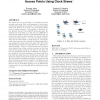Free Online Productivity Tools
i2Speak
i2Symbol
i2OCR
iTex2Img
iWeb2Print
iWeb2Shot
i2Type
iPdf2Split
iPdf2Merge
i2Bopomofo
i2Arabic
i2Style
i2Image
i2PDF
iLatex2Rtf
Sci2ools
TMC
2010
2010
On Fast and Accurate Detection of Unauthorized Wireless Access Points Using Clock Skews
We explore the use of clock skew of a wireless local area network access point (AP) as its fingerprint to detect unauthorized APs quickly and accurately. The main goal behind using clock skews is to overcome one of the major limitations of existing solutions - the inability to effectively detect Medium Access Control (MAC) address spoofing. We calculate the clock skew of an AP from the IEEE 802.11 Time Synchronization Function (TSF) timestamps sent out in the beacon/probe response frames. We use two different methods for this purpose - one based on linear programming and the other based on least square fit. We supplement these methods with a heuristic for differentiating original packets from those sent by the fake APs. We collect TSF timestamp data from several APs in two different residential settings. Using our measurement data as well as data obtained from a large conference setting, we find that clock skews remain consistent over time for the same AP but vary significant...
| Added | 31 Jan 2011 |
| Updated | 31 Jan 2011 |
| Type | Journal |
| Year | 2010 |
| Where | TMC |
| Authors | Suman Jana, Sneha Kumar Kasera |
Comments (0)

